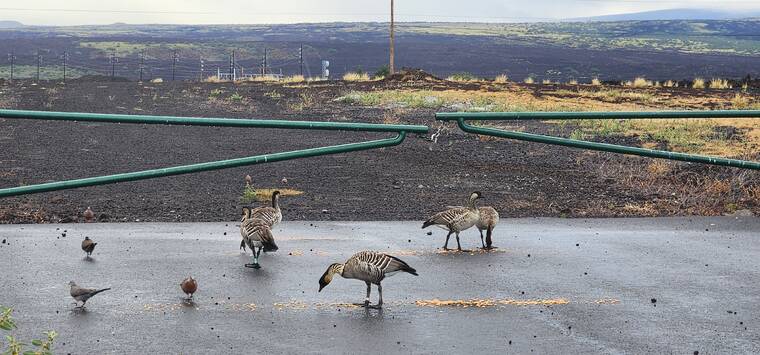WAIKOLOA — Department of Land and Natural Resources Chair Dawn Chang met Tuesday with the principals of ABayKitties, the organization that has provided cat food at a trio of feeding stations at the Queens’ Marketplace shopping center.
The meeting was at the direction of Gov. Josh Green.
Last week, property owner Alexander & Baldwin removed the feeders after learning that as many as a dozen nene were also eating cat food.
In Chang’s meeting with ABayKitties, she reiterated that the DLNR is required by law to protect nene, an endangered species under state law, and a threatened species under the federal Endangered Species Act.
According to a DLNR press release, Chang explained when nene eat cat food, it can make them sick and can even kill them. Toxoplasmosis, a disease carried by cats, can also kill birds and critically endangered Hawaiian monk seals. Feral cats are among the most prolific predators of numerous near-extinct native forest birds.
Chang told ABayKitties that she appreciates their passion but pointed out that Native Hawaiians, numerous conservation organizations, and many local residents strongly support the protection of nene and other native animals, birds and mammals.
Calls by the Tribune-Herald to ABayKitties director Dawn Garlinghouse were not returned in time for this story.
Feeding wildlife like nene can “habituate” them to being around people, which leads to more frequent car strikes, and even the abduction of young birds, as happened in Hilo last month.
Dozens of e-mails and phone calls received by DLNR and A&B show widespread support for stopping the feeding of feral cats, according to the press release.
While there have been no recent statewide surveys of the feral cat population, estimates put the number into the hundreds of thousands. On Hawaii Island, a 2021 survey of the nene population puts the number of birds at 1,074. Statewide, the same survey indicated a population of 3,881.
On April 11, during a protest by feral cat advocates, two women were cited for the illegal take of an endangered or threatened species. Those citations will require court appearances next month.
Private property owners such as A&B have the right to decide what kinds of activities are permitted on their lands, according to the DLNR.
The DLNR Division of Forestry and Wildlife, or DOFAW, is preparing informational flyers to distribute to property owners and individuals to educate people about how to avoid harming nene.
The department has been in regular contact with area legislators who want to find a permanent solution, and is also arranging meetings with Hawaii County and with humane societies to work collaboratively.
“This is not just a Waikoloa issue. This is not just a Hawaii Island issue,” Chang said in a statement. “This is not an issue of lovers of feral cats versus lovers of native wildlife, so this is a problem without easy or readily identifiable solutions. Our mission is to protect Hawaii’s unique and precious wildlife. We take that seriously and to heart. While we have compassion for all living creatures, our singular mission is to protect our native threatened and endangered species from all threats.”



